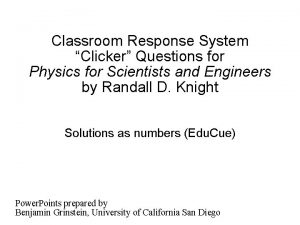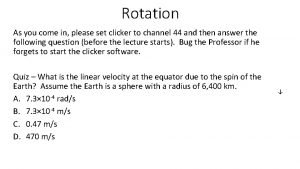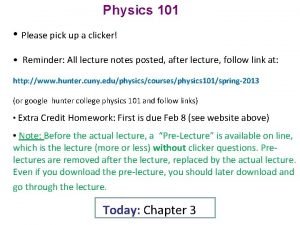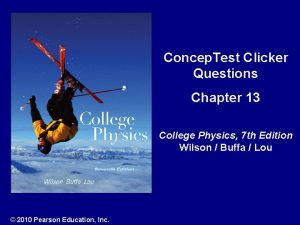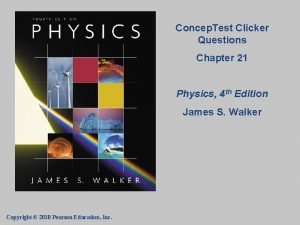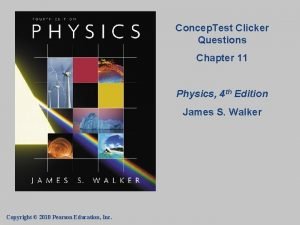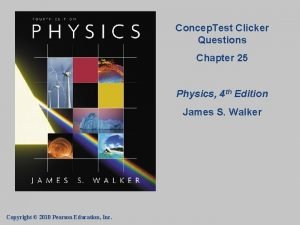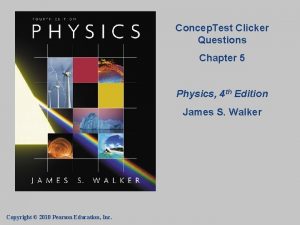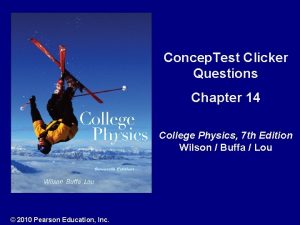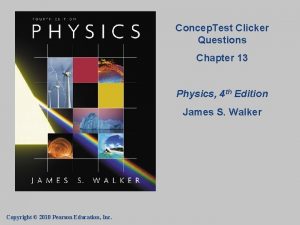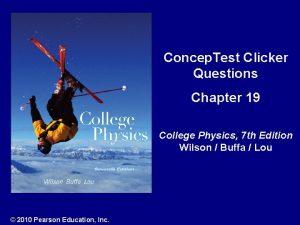Concep Test Clicker Questions Chapter 31 Physics 4















- Slides: 15

Concep. Test Clicker Questions Chapter 31 Physics, 4 th Edition James S. Walker Copyright © 2010 Pearson Education, Inc.

Question 31. 1 Ionization a) 0 e. V How much energy does it b) 13. 6 e. V take to ionize a hydrogen c) 41. 2 e. V atom in its ground state? d) 54. 4 e. V e) 108. 8 e. V

Question 31. 1 Ionization a) 0 e. V How much energy does it b) 13. 6 e. V take to ionize a hydrogen c) 41. 2 e. V atom in its ground state? d) 54. 4 e. V e) 108. 8 e. V The energy of the ground state is the energy that binds the electron to the nucleus. Thus, an amount equal to this binding energy must be supplied in order to kick the electron out of the atom. Follow-up: How much energy does it take to change a He+ ion into a He++ ion? Keep in mind that Z = 2 for helium.

Question 31. 2 a Atomic Transitions I For the possible transitions shown, for which transition will the electron gain the most energy? a) 2 5 b) 5 3 c) 8 5 d) 4 7 e) 15 7 n=5 n=4 n=3 n=2 n=1

Question 31. 2 a Atomic Transitions I For the possible transitions shown, for which transition will the electron gain the most energy? The electron must go to a higher orbit (higher n) in order for the electron to gain energy. Because of the 1/n 2 dependence: E 2 – E 5 > E 4 – E 7 a) 2 5 b) 5 3 c) 8 5 d) 4 7 e) 15 7 n=5 n=4 n=3 n=2 n=1 Follow-up: Which transition will emit the shortest wavelength photon?

Question 31. 2 b Atomic Transitions II The Balmer series for hydrogen a) 3 2 can be observed in the visible part b) 4 2 of the spectrum. Which transition c) 5 2 leads to the reddest line in the d) 6 2 spectrum? e) 2 n= n=6 n=5 n=4 n=3 n=2 n=1

Question 31. 2 b Atomic Transitions II The Balmer series for hydrogen a) 3 2 can be observed in the visible part b) 4 2 of the spectrum. Which transition c) 5 2 leads to the reddest line in the d) 6 2 spectrum? e) 2 The transition 3 2 has the lowest energy and thus the lowest frequency photon, which corresponds to the longest n= n=6 n=5 n=4 n=3 n=2 wavelength (and therefore the “reddest”) reddest line in the spectrum. n=1 Follow-up: Which transition leads to the shortest wavelength photon?

Question 31. 3 When a broad spectrum of light passes through hydrogen gas at room temperature, absorption lines are observed that correspond only to the Balmer (nf = 2) series. Why aren’t other series observed? Balmer Series a) they’re there, but they’re invisible b) only the Balmer series can be excited at room temperature c) the other series have been ionized d) all the photons have been used up

Question 31. 3 When a broad spectrum of light passes through hydrogen gas at room temperature, absorption lines are observed that correspond only to the Balmer (nf = 2) series. Why aren’t other series observed? The Balmer series is the only one that involves wavelengths in the visible part of the spectrum! Follow-up: From the diagram at right, where in the EM spectrum is the Lyman series located? Balmer Series a) they’re there, but they’re invisible b) only the Balmer series can be excited at room temperature c) the other series have been ionized d) all the photons have been used up

Question 31. 4 a Suppose there is an atom that Energy Levels I a) 4 contains exactly five energy b) 5 levels. How many different c) 10 transitions are possible? (Count d) 20 only one direction!) e) many more than 20 n=5 n=4 n=3 n=2 n=1

Question 31. 4 a Energy Levels I Suppose there is an atom that a) 4 contains exactly five energy b) 5 levels. How many different c) 10 transitions are possible? (Count d) 20 only one direction!) e) many more than 20 Just count them! Transitions upward: upward n=1 n=? 4 transitions n=2 n=? 3 transitions n=3 n=? 2 transitions n=4 n=? 1 transition This gives a total of 10 possible ones n=5 n=4 n=3 n=2 n=1

Question 31. 4 b Energy Levels II The emission spectrum for the atoms of a gas is shown. Which of the energy level diagrams below corresponds to this spectrum? a) b) c) d)

Question 31. 4 b Energy Levels II The emission spectrum for the atoms of a gas is shown. Which of the energy level diagrams below corresponds to this spectrum? a) b) c) d) Each line in the spectrum corresponds to a transition between energy levels! Since there are 6 transitions shown, there must be 4 levels The 2 transitions between the closely spaced levels have less energy, while the other 4 have larger energies

Question 31. 5 Rutherford Model Suppose the Rutherford a) there would be no change model was correct b) the absorption lines would be broader (instead of the Bohr c) it would be completely black model). What would the d) the absorption lines would be shifted absorption spectrum of a hydrogen atom look like? e) the absorption lines would be bright instead of dark

Question 31. 5 Rutherford Model Suppose the Rutherford a) there would be no change model was correct b) the absorption lines would be broader (instead of the Bohr c) it would be completely black model). What would the d) the absorption lines would be shifted absorption spectrum of a hydrogen atom look like? e) the absorption lines would be bright instead of dark In the Rutherford model, all orbits are allowed for the electrons. Thus, the atom would be able to absorb all wavelengths of light instead of only the specific ones allowed in the Bohr model.
 Clicker questions physics
Clicker questions physics Gamit ang web mapping magbigay ng mga alam mong kultura
Gamit ang web mapping magbigay ng mga alam mong kultura Math clicker
Math clicker E clicker
E clicker Audience response clicker
Audience response clicker Lesson 5 building an app clicker game
Lesson 5 building an app clicker game Earth clicker
Earth clicker Maximal heart rate
Maximal heart rate Japan movie rape
Japan movie rape Clicker stop motion
Clicker stop motion Cooi clicker
Cooi clicker Umbc clicker
Umbc clicker Clicker box
Clicker box Roger rabbit
Roger rabbit Clicker stop motion
Clicker stop motion Clicker
Clicker
